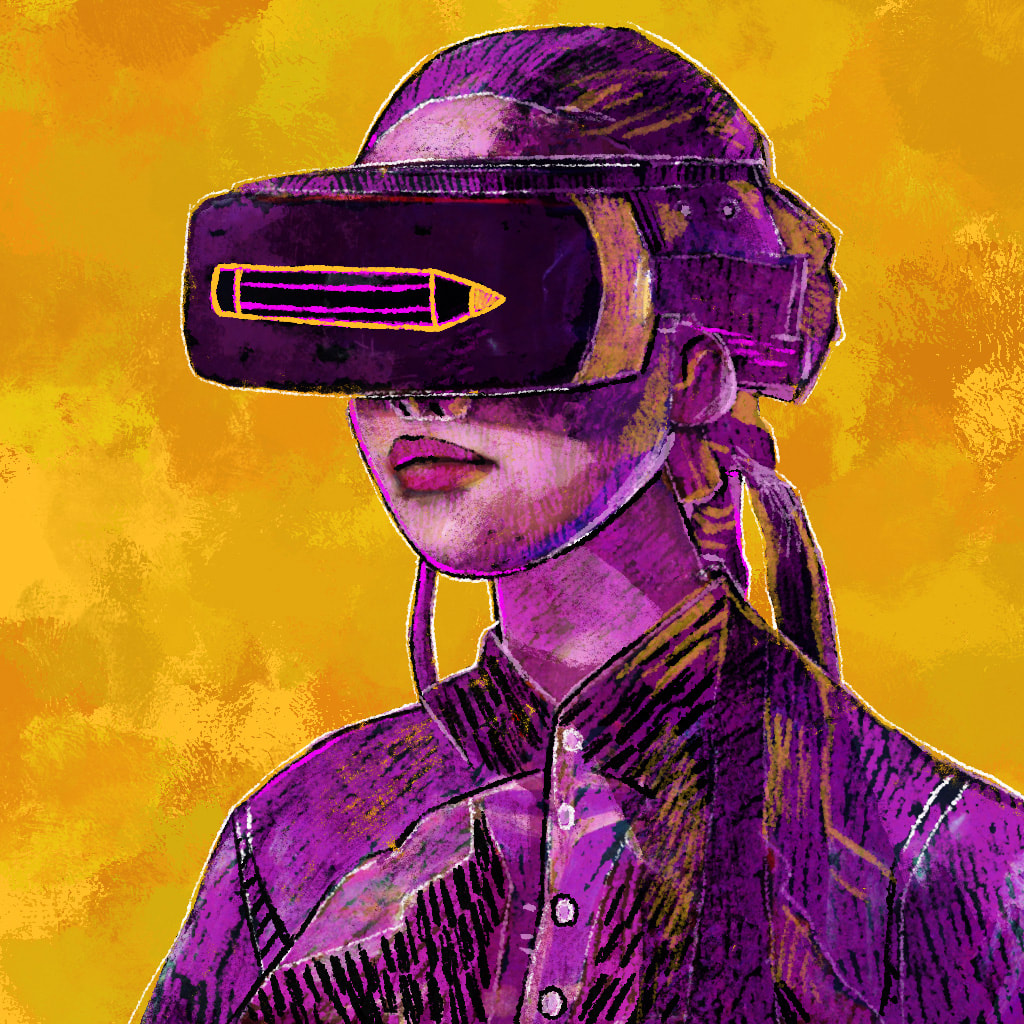|
(illustration SVdB) In the ever-evolving landscape of technology, two groundbreaking advancements, Artificial Intelligence (AI) and Augmented Reality (AR), are reshaping the way we perceive and interact with the world around us. While AI revolutionizes creativity and design processes, AR introduces immersive experiences that blur the lines between the physical and digital realms. In this blog, we delve into the fusion of AI and AR and explore its profound impact on the future of illustration. The Rise of AI in Illustration: AI has emerged as a powerful tool in the realm of illustration, offering artists new avenues for creativity and efficiency. With AI-powered tools, illustrators can now streamline their workflows, generate ideas, and enhance their artistic capabilities. One of the most notable applications of AI in illustration is the creation of generative art, where algorithms autonomously produce intricate designs and patterns based on predefined parameters. This not only expands the creative horizons of artists but also challenges traditional notions of authorship and creativity. Furthermore, AI-driven style transfer algorithms enable illustrators to effortlessly apply various artistic styles to their work, from impressionism to cubism, with just a few clicks. This versatility empowers artists to experiment with different aesthetics and push the boundaries of traditional illustration techniques. Additionally, AI-powered image recognition and classification tools facilitate the process of content creation by automatically tagging and categorizing visual assets, thereby streamlining the search for reference materials and inspiration. Augmented Reality: Bridging the Physical and Digital Realms: Augmented Reality has rapidly gained momentum as a transformative technology that overlays digital content onto the physical world, thereby enhancing our perception of reality. With the proliferation of AR-enabled devices, such as smartphones and smart glasses, users can seamlessly integrate virtual elements into their surroundings, opening up new possibilities for storytelling and interactive experiences. In the realm of illustration, AR offers a dynamic canvas for artists to showcase their work in immersive and interactive ways. Through AR applications, viewers can experience illustrations come to life, with characters animated and environments dynamically evolving as they explore the augmented space. This interactive dimension not only captivates audiences but also fosters deeper engagement and emotional connections with the artwork. Moreover, AR enables illustrators to transcend the constraints of traditional media by integrating digital elements into physical spaces. Whether it's murals that transform into animated narratives or interactive installations that respond to audience interactions, AR empowers illustrators to create multisensory experiences that transcend the limitations of static imagery. The Synergy of AI and AR: The convergence of AI and AR holds immense potential for the future of illustration, as it combines the creative prowess of AI with the immersive capabilities of AR to redefine the way we perceive and interact with visual content. By leveraging AI-generated assets within AR environments, illustrators can create dynamic and adaptive experiences that respond to user input and environmental cues. For instance, AI-powered character generators can autonomously create diverse and lifelike characters, which can then be seamlessly integrated into AR scenes, where they interact with users in real-time. Additionally, AI-driven content personalization algorithms can tailor AR experiences to individual preferences, delivering personalized narratives and interactions based on user demographics and behavior. Furthermore, the marriage of AI and AR democratizes the creation and consumption of illustration, as it empowers individuals with limited artistic skills to express themselves creatively in AR environments. Through intuitive AI-driven tools, users can easily generate and customize AR content, transforming everyday spaces into personalized canvases for self-expression and storytelling. Conclusion: As AI and AR continue to advance and converge, the future of illustration is poised for a paradigm shift. The synergy of AI-driven creativity and AR-enabled immersion promises to usher in a new era of interactive and immersive storytelling, where the boundaries between the physical and digital worlds dissolve. Whether it's AI-generated characters coming to life in AR environments or immersive illustrations that respond to user interactions, the fusion of AI and AR holds boundless possibilities for the evolution of illustration in the digital age. #FutureIllustration #AIillustration #AugmentedRealityArt #DigitalArtistry #TechIllustration #ARIllustration #IllustrationTech #ArtificialIntelligenceArt #ARDesign #DigitalImagination #IllustrationInnovation #ARCreation #AIcreativity #NextGenIllustration #AugmentedCreativity #DigitalInnovation #ARArtists #AIInspiredArt #IllustrationTrends #FutureTechArt
0 Comments
Introduction The rapid advancements in artificial intelligence (AI) have sparked debates and discussions about the impact it has on various industries. One such industry that has witnessed both challenges and opportunities due to AI is the field of illustration. Traditionally, illustrators have been known for their creativity and unique artistic skills, but with the integration of AI, their roles and workflows are undergoing significant changes. In this blog post, we will explore the transformative impact of AI on the job of illustrators and the implications it holds for the future. AI as a Creative Tool AI has emerged as a powerful tool in the hands of illustrators, assisting them in enhancing their creative process and output. With AI-powered software, artists can generate preliminary sketches, experiment with different styles and visual elements, and even create lifelike illustrations. Tools like deep learning algorithms can analyze vast amounts of existing artwork, enabling artists to draw inspiration from a wide range of styles and techniques. The availability of AI-generated content can also serve as a valuable resource for illustrators. Websites and platforms like Unsplash and Shutterstock offer extensive libraries of images that artists can use as references or as a base for their work. This abundance of visual material provides illustrators with new opportunities to explore and expand their artistic visions. Streamlining Workflow and Efficiency In addition to being a creative tool, AI has proven to be an efficient assistant in streamlining the workflow of illustrators. Automation technologies powered by AI can help with repetitive tasks such as resizing images, color correction, and background removal. This allows illustrators to focus more on the creative aspects of their work, saving time and increasing productivity. Moreover, AI-driven algorithms can analyze the needs and preferences of clients, aiding illustrators in delivering customized and tailored designs. By leveraging machine learning techniques, illustrators can gain insights into target audiences, market trends, and consumer demands, helping them create illustrations that align with the expectations of their clients. Challenges and Adaptation While AI brings numerous benefits, it also poses certain challenges for illustrators. One of the primary concerns is the potential for job displacement. As AI advances in generating realistic artwork, there is a possibility that some routine illustration tasks may become automated, reducing the demand for human illustrators in certain areas. However, it is important to note that AI cannot replicate the imagination, emotions, and storytelling abilities of human illustrators. Artistic vision, creativity, and the ability to capture the essence of a concept or narrative are elements that remain uniquely human. Rather than replacing illustrators, AI can be seen as a tool that enhances their capabilities and opens up new creative possibilities. Embracing Collaboration and New Avenues The integration of AI also presents illustrators with opportunities for collaboration. AI technologies enable illustrators to work seamlessly with other professionals, such as writers, designers, and animators. Collaborative platforms and software allow for real-time communication, feedback, and efficient sharing of resources, ultimately leading to more refined and compelling illustrations. Furthermore, the rise of AI has opened up new avenues for illustrators. As technology continues to evolve, new roles such as AI illustrators, concept artists for AI-driven projects, or designers for virtual and augmented reality experiences are emerging. Illustrators who embrace AI and acquire the necessary skills to navigate these domains can expand their career prospects and explore innovative applications of their craft. Conclusion AI has undeniably made a transformative impact on the job of illustrators, revolutionizing their creative process, enhancing efficiency, and presenting new challenges and opportunities. Rather than replacing human artists, AI serves as a valuable tool that complements their skills and broadens their artistic horizons. By embracing AI, illustrators can navigate the evolving landscape, collaborate across disciplines, and continue to captivate audiences with their unique blend of creativity and imagination. As the field evolves, the symbiotic relationship between AI and illustrators will continue to shape the future of visual storytelling and artistic expression. #illustration #graphicdesign #ai #artificialintelligence #instadaily #painting #training #graphicsdesign #designgraphic #graphicdesigndaily (Illustration generated with AI: Dall-E)
|
AuthorSeppe is a Ostend-based visual-designer and illustrator. ArchivesCategories |



 RSS Feed
RSS Feed